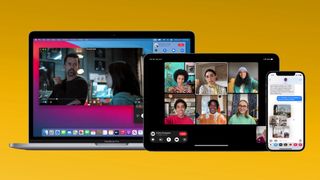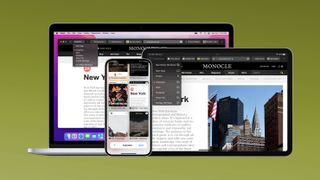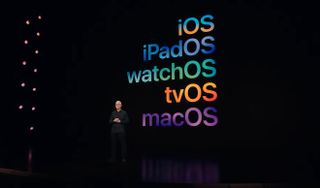iOS 15 and macOS Monterey — Apple’s walled garden just got even higher
Apple is putting a lot of focus on features that work across Macs, iPhones and iPads

It's fitting that Apple keeps turning to the state of California for inspiration when naming macOS releases like the new macOS Monterey. With all the cross-device features introduced during Apple's Worldwide Developer Conference earlier this week, the company has solidified its place as the Hotel California of tech companies — you can check out of your iPhone, iPad or Mac any time you like, but you can never leave.
Making sure its devices play nicely with each other isn't anything out of the ordinary for Apple. When you build both the software and hardware, you can do things like make sure that your phones, tablets, computers and smartwatches work in concert.
- WWDC 2021 recap: All of Apple’s announcements in one place
- These are the 15 best new features in iOS 15
- Plus: The killer feature of iOS 15 — holy cow, it’s actually Siri
It's an effective incentive for jumping into Apple's ecosystem with both feet. I'd never even thought about owning an Apple Watch until I saw my wife use hers to unlock her iPhone with her face mask still on. Now I'm wondering whether it's time for me to revisit my anti-wristwatch stance.
But at WWDC 2021 this past week, Apple really drove home the point that once you own one of its products, you really should just give in and buy all of its products. It's not a coincidence that many of the coolest features included in Apple's upcoming software updates work across multiple platforms, as Apple seemed to make the interoperability of macOS Monterey, iOS 15, iPadOS 15 and watchOS 8 the order of the day.
Apple tightens the ties that bind Macs, iPhones, iPads
Take the SharePlay feature coming to FaceTime, which lets you and the people you video-message with share movies, TV shows, songs, and even screens. That new capability may have been touted as part of the iOS 15 update, but the fact that you can use SharePlay with people using FaceTime on the upcoming versions of macOS and iPadOS certainly didn't go unmentioned.

Likewise, the Safari web browser is getting an overhaul on macOS Monterey, highlighted by a streamlined tab bar that takes up less space. That same philosophy guides the new look of Safari in iOS 15: The tab bar is much smaller and has moved down to the bottom of the page to be more unobtrusive and also to make it easier to navigate with one hand. Tab groups — a new way of organizing similar tabs — is supported by Safari on multiple devices; your group tabs on one platform will follow you over to another.
That theme continues across a number of different features Apple's planning for the fall. You'll find Focus mode on your iPhone, iPad and Mac, and the notification settings you enable on one device will also be observed by the others.
Sign up to get the BEST of Tom’s Guide direct to your inbox.
Upgrade your life with a daily dose of the biggest tech news, lifestyle hacks and our curated analysis. Be the first to know about cutting-edge gadgets and the hottest deals.
Apple's message: Sure, you could try someone else's hardware. But why do that when all these features play so nicely together?
macOS's Universal Control feature requires an iPad, as the new capability lets you use the same mouse and keyboard seamlessly on both a Mac and one of Apple's tablets. The upcoming virtual-key features Apple's adding to your Wallet app work just as easily with your Apple Watch as they do with your iPhone.
Apple's message here is clear: Sure, you could try someone else's hardware. But why do that when all these features play so nicely with our other products?
Apple's betting you'll stick around
Not that there's anything sinister about this. I like when my Apple devices work in concert. Having Safari tabs I've left open on my Mac available on my iPhone, passing directions from laptop to phone, making sure things stay synced with iCloud — these are all conveniences that improve my experience on all my devices.
The trouble is, it makes it that much harder to consider alternatives if any one part of the Apple Cinematic Universe isn't up to snuff. I'm typing this article on a 2018 MacBook Air, and, frankly, if this were the first Apple laptop I ever bought, it would certainly be the last.
But picking up a comparable Windows laptop — a Microsoft Surface Laptop 4, say, or one of those 5G laptops that are hitting the market — means I have to give up the conveniences of a synced laptop-phone experience. Some of the most compelling features Apple introduced this week, like the Focus mode that follows me from device to device, would be of no use to me in the future. (I would be able to take advantage of SharePlay features on an Android or Windows device, but only through a web interface. I mean, what am I, a peasant?)
"Nice walled garden," Apple may as well be saying. "Shame if someone were to want to leave it."

Beyond the convenience to folks like you and me, Apple has perfectly sound business reasons for strengthening the hooks between iPhones, Macs, Apple Watches and iPads, and not just because it makes for a fun bullet point about the company's active installed base during quarterly earnings calls with Wall Street.
Apple's walled garden gets stronger
The more tie-ins between Apple's different products, the more people are likely to use Apple's subscription services for additional integration. And that makes people more likely to stick with Apple when it's time to upgrade any of the devices they own. It translates to lots of revenue, recurring and otherwise.
In the meantime, I guess there are worse things than to be "stuck" in an ecosystem that keeps adding features that work on all my devices. Leaving Apple's bright, shiny world may be difficult to do, but it seems the company wants to make sure that none of us even contemplate checking out in the first place.
- iPad vs iPad Air vs iPad mini: Which tablet is right for you?
- Amazon Prime Day deals 2021 — dates and what to expect
Philip Michaels is a Managing Editor at Tom's Guide. He's been covering personal technology since 1999 and was in the building when Steve Jobs showed off the iPhone for the first time. He's been evaluating smartphones since that first iPhone debuted in 2007, and he's been following phone carriers and smartphone plans since 2015. He has strong opinions about Apple, the Oakland Athletics, old movies and proper butchery techniques. Follow him at @PhilipMichaels.

